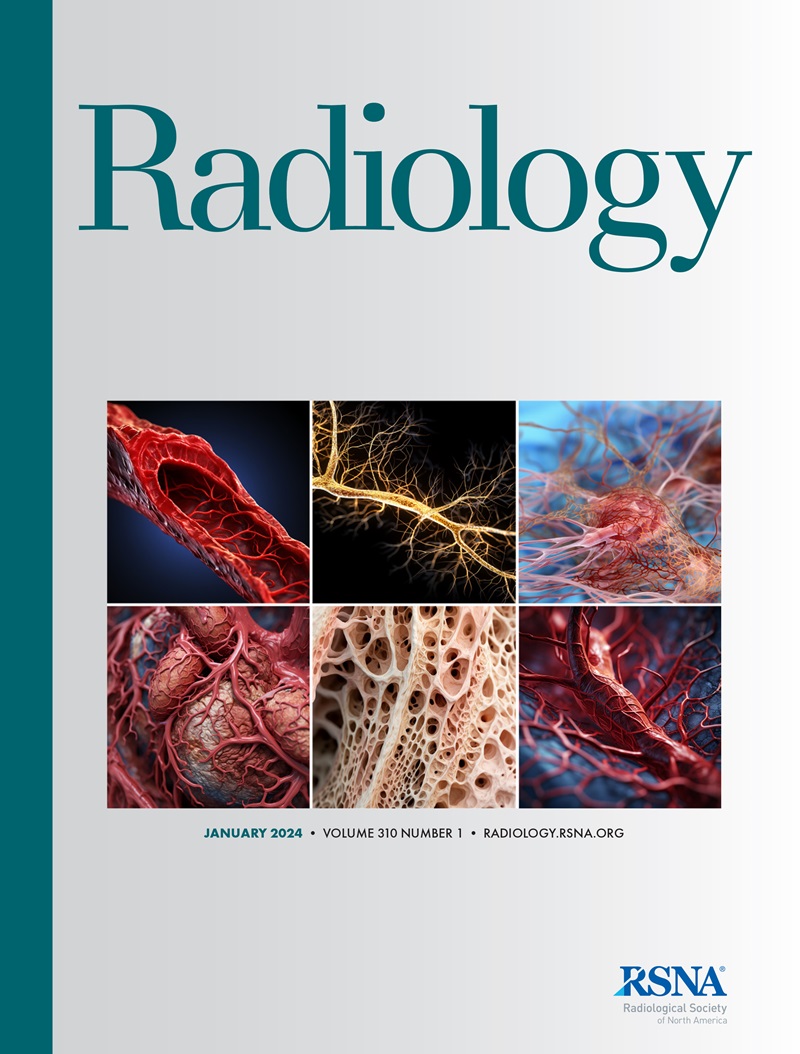Joao V Horvat, Tali Amir, Gordon P Watt, Christopher E Comstock, Noam Nissan, Maxine S Jochelson, Janice S Sung
下载PDF
{"title":"Comparison of Contrast-enhanced Mammography and Low-Energy Imaging with or without Supplemental Whole-Breast US in Breast Cancer Detection.","authors":"Joao V Horvat, Tali Amir, Gordon P Watt, Christopher E Comstock, Noam Nissan, Maxine S Jochelson, Janice S Sung","doi":"10.1148/radiol.242006","DOIUrl":null,"url":null,"abstract":"<p><p>Background Contrast-enhanced mammography (CEM) is an emerging modality that generates low-energy (LE) images that are visually equivalent to full-field digital mammography (FFDM) and recombined images that show lesion vascularity such as MRI. Supplemental whole-breast US increases cancer detection rates when performed with FFDM but not with MRI. Purpose To compare the performance of CEM, LE images, and LE images supplemented with whole-breast US in breast cancer detection during screening. Materials and Methods This prospective study recruited female participants from December 2014 to February 2019 who were scheduled for screening mammography and whole-breast US. CEM (including LE images and recombined images) and whole-breast US images were interpreted by separate breast radiologists blinded to the findings on images from the other modality. Statistical differences in sensitivity and specificity, positive predictive value (PPV), negative predictive value, and abnormal interpretation rate were assessed. Biopsy recommendation rate and PPVs of biopsies performed (PPV<sub>3</sub>) were calculated at the lesion level. Results Across 468 participants (median age, 54 years [IQR, 48-59 years]; all female participants), nine screen-detected cancers were diagnosed in eight participants: one cancer was depicted at LE imaging alone (cancer detection rate, 2.1 of 1000), four were depicted at LE imaging with whole-breast US (cancer detection rate, 8.5 of 1000), and eight were depicted at CEM (cancer detection rate, 17.1 of 1000; <i>P</i> < .05). The abnormal interpretation rate was 10.3% (48 of 468) for LE images, 13.7% (64 of 468) for LE images with whole-breast US, and 18.6% (87 of 468) for CEM (<i>P</i> < .001). The biopsy recommendation rate was 15.0 of 1000 for LE images, 38.4 of 1000 for LE images with whole-breast US, and 42.7 of 1000 for CEM. Seven biopsies were recommended based on LE images (PPV<sub>3</sub> of one of seven [14.3%]), 18 biopsies based on LE images with whole-breast US (with a PPV<sub>3</sub> of five of 18 [27.8%]), and 20 biopsies based on CEM (PPV<sub>3</sub> of 9 of 20 [45.0%]). Conclusion Breast cancer detection improved with CEM compared with LE images alone or LE images with whole-breast US. ClinicalTrials.gov Identifier: NCT02310698 © RSNA, 2025 <i>Supplemental material is available for this article.</i></p>","PeriodicalId":20896,"journal":{"name":"Radiology","volume":"314 3","pages":"e242006"},"PeriodicalIF":12.1000,"publicationDate":"2025-03-01","publicationTypes":"Journal Article","fieldsOfStudy":null,"isOpenAccess":false,"openAccessPdf":"https://www.ncbi.nlm.nih.gov/pmc/articles/PMC11950873/pdf/","citationCount":"0","resultStr":null,"platform":"Semanticscholar","paperid":null,"PeriodicalName":"Radiology","FirstCategoryId":"3","ListUrlMain":"https://doi.org/10.1148/radiol.242006","RegionNum":1,"RegionCategory":"医学","ArticlePicture":[],"TitleCN":null,"AbstractTextCN":null,"PMCID":null,"EPubDate":"","PubModel":"","JCR":"Q1","JCRName":"RADIOLOGY, NUCLEAR MEDICINE & MEDICAL IMAGING","Score":null,"Total":0}
引用次数: 0
引用
批量引用
Abstract
Background Contrast-enhanced mammography (CEM) is an emerging modality that generates low-energy (LE) images that are visually equivalent to full-field digital mammography (FFDM) and recombined images that show lesion vascularity such as MRI. Supplemental whole-breast US increases cancer detection rates when performed with FFDM but not with MRI. Purpose To compare the performance of CEM, LE images, and LE images supplemented with whole-breast US in breast cancer detection during screening. Materials and Methods This prospective study recruited female participants from December 2014 to February 2019 who were scheduled for screening mammography and whole-breast US. CEM (including LE images and recombined images) and whole-breast US images were interpreted by separate breast radiologists blinded to the findings on images from the other modality. Statistical differences in sensitivity and specificity, positive predictive value (PPV), negative predictive value, and abnormal interpretation rate were assessed. Biopsy recommendation rate and PPVs of biopsies performed (PPV3 ) were calculated at the lesion level. Results Across 468 participants (median age, 54 years [IQR, 48-59 years]; all female participants), nine screen-detected cancers were diagnosed in eight participants: one cancer was depicted at LE imaging alone (cancer detection rate, 2.1 of 1000), four were depicted at LE imaging with whole-breast US (cancer detection rate, 8.5 of 1000), and eight were depicted at CEM (cancer detection rate, 17.1 of 1000; P < .05). The abnormal interpretation rate was 10.3% (48 of 468) for LE images, 13.7% (64 of 468) for LE images with whole-breast US, and 18.6% (87 of 468) for CEM (P < .001). The biopsy recommendation rate was 15.0 of 1000 for LE images, 38.4 of 1000 for LE images with whole-breast US, and 42.7 of 1000 for CEM. Seven biopsies were recommended based on LE images (PPV3 of one of seven [14.3%]), 18 biopsies based on LE images with whole-breast US (with a PPV3 of five of 18 [27.8%]), and 20 biopsies based on CEM (PPV3 of 9 of 20 [45.0%]). Conclusion Breast cancer detection improved with CEM compared with LE images alone or LE images with whole-breast US. ClinicalTrials.gov Identifier: NCT02310698 © RSNA, 2025 Supplemental material is available for this article.

 求助内容:
求助内容: 应助结果提醒方式:
应助结果提醒方式:


